
Emergence of Intelligence
Key points: Convergent evolution; encephalization; trend toward increasing brain size and what drives it; comparison of human brain with others
Effect of Mass Extinctions on Evolution
Mass extinctions clearly lead to major changes in direction of the general pattern of evolution. For example, the K/T Event killed off the highly successful dinosaurs and made possible the rise of mammals. Mammals had led a marginal existence for millions of years before the event and it seems unlikely that they would have emerged as the dominant large animal type without this help.
Does this mean that the direction of evolution is random, with unpredictable changes of direction at each mass extinction? Would the earth never have involved a species intelligent enough to ask about its origins, without the K/T Event??? And is the evolution of similar intelligence elsewhere determined by rolling the dice in this same way? There is debate over the answers. The question is whether evolution takes the same path, more or less, given the same conditions, or whether this path is largely random. To understand this issue further, we discuss "convergent evolution."
| Similar features in different animals often arise because they have evolved from a feature in a common ancestor. An example is the forelimb of mammals. (Illustration from http://www.ucmp.berkeley.edu/) |  |
| Evolution can also work to produce similar solutions to similar
problems for survival, without those solutions being derived from the same ancestor. The
figure to the right compares the wing of a pterodactyl (a
flying reptile), a bird, and a bat (a mammal). These structures appear to originate
independently, both because they are from quite different classes of animal and from
examining their details. Thus, in the pterodactyl, the wing membrane is supported by the
5th finger of the forelimb, in the bird by the 2nd finger, and in the bat, by the 3rd, 4th
and 5th fingers. (Illustration from http://www.ucmp.berkeley.edu/) All three structures evolved from the
forelimbs of the ancestors of these animals, but evidently along different routes. The
problems of flying for large animals (that is, larger than insects) are the same,
independent of the animal. Thus, the variety of solutions is limited and all three of the
flyers to the right evolved nearly identical ones. This process is known as convergent evolution |
 |
However, occasionally evolution does not converge to similar solutions.
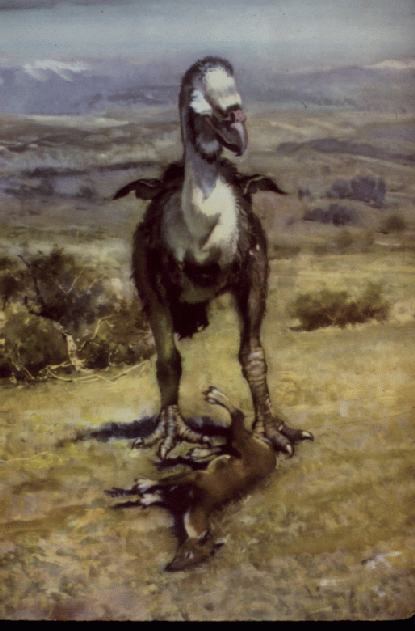 |
South America was isolated from other large land masses for millions
of years following the K/T event, and a large flightless bird, the Phorusrhacos, evolved
to become the dominant predator. These fearsome creatures were 6 - 10 feet tall.
(right from http://www.bbc.co.uk/beasts/evidence/prog5/page6.shtml left from http://www.ucmp.berkeley.edu/vertebrates/flight/aves.html
|
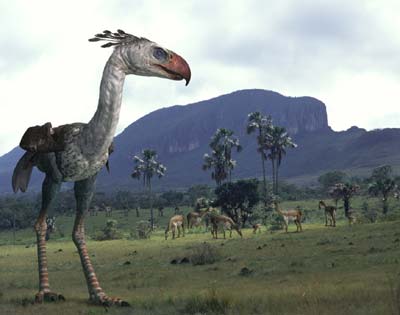 |
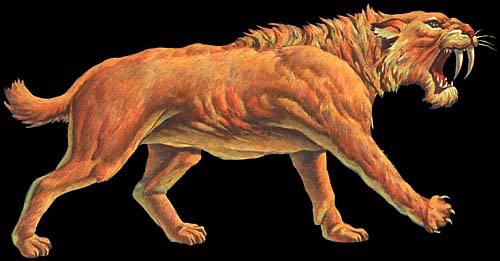 |
At the same time, in the merged Africa-Europe-Asia-North America, large cats were the dominant predators, such as this Smilodon (Saber Tooth) that ruled North America. Smilodons were about 5 feet long and 3 feet high. (From Joe Tucciarone, http://prehistoricsillustrated.com/pg_jtu_39.html) When plate motions carried South America into contact with North America, the cats invaded and took over top spot. The Phorushacos also invaded North America, but eventually became extinct. Eventually the saber tooths also died out, but large cats remain the most powerful predators in both North and South America. |
So we reach a wishy-washy conclusion. Mass extinctions and other major challenges to evolution frequently lead to similar solutions - convergent evolution - starting from dis-similar organisms, but there are also examples where such events set things off in new and different directions in a somewhat random fashion. Still, it is generally agreed that evolution proceeds in a generally predictable path, and that it makes sense to consider something as fundamental as the emergence of intelligence as nearly inevitable.
How did Intelligent Life Emerge?
The "encephalization level" is the ratio of the brain weight of the animal to the brain weight of a "typical" animal of the same body weight. It is related to animals of different weights as
(encephalization level) = (constant) times (brain mass) divided by (body mass)2/3,
It lets us guess at the intelligence of the animal, assuming that the
"extra" brain is used for that purpose. Here is an example that may make the
concept clearer![]() This graph shows the
increase in encephalization level for various human-like primates over the past 3 million
years (after Endless Forms Most Beautiful, Sean B. Carroll):
This graph shows the
increase in encephalization level for various human-like primates over the past 3 million
years (after Endless Forms Most Beautiful, Sean B. Carroll):
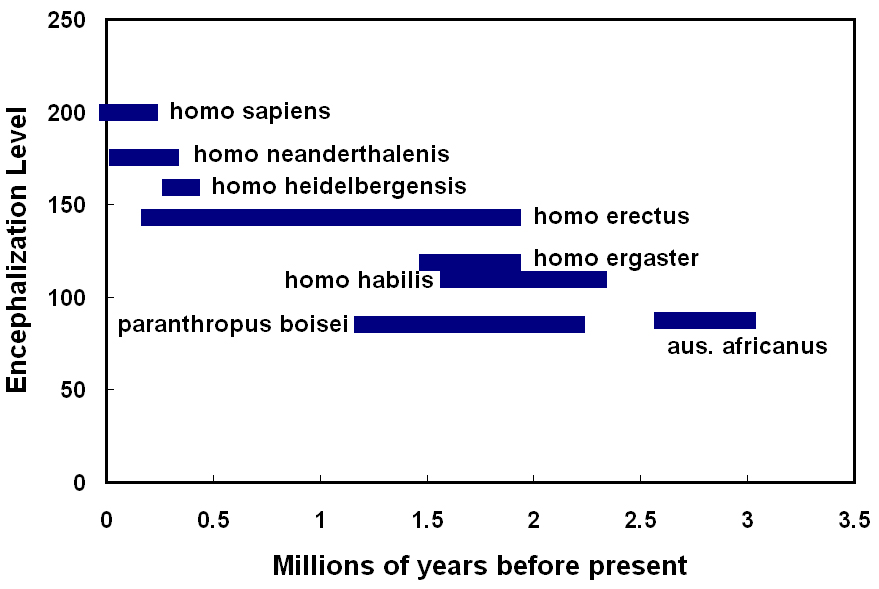
Here is how it has changed over the history of life on Earth (from D. Russell, http://history.nasa.gov/CP-2156/ch4.3.htm#263).

The dots and solid lines represent the highest values at each age. From this trend we see:
But large brains do not necessarily produce the kind of intelligence that might
build complex machines, write books, and inquire about its origins.![]()
What is needed to produce powerful brains?
Our brains take huge resources to maintain - 25% of the energy expended by your body keeps your brain going. In addition, large thinking brains make many demands on the species:
An illustrations of the first bullet is that the encephalization of warm blooded animals - birds and mammals - is systematically nearly ten times higher than that of cold blooded ones - reptiles, amphibians, and typical fish. The second bullet is supported by the exception to this rule, for sharks. They have by far the highest encephalization of the fish, presumably as a result of the challenges imposed by being such effective predators. Similarly, killer whales have huge brains, up to 15 pounds.
How did we get powerful, versatile, thinking brains like ours??
| About 55 million years ago, 10 million years after the K/T event, primitive primates, similar to this loris, became abundant. They only weighed a few ounces and clung to the ends of branches in the forests with prehensile hands and feet. They had excellent eyesight, with forward-facing eyes - probably for the dual purposes of allowing them to judge safe footholds in the branches and to improve their ability to hunt insects. They had gained superb motor skills and vision to allow them to occupy an environmental niche rich in easily digested foods -- insects and fruits. (from J. Allman, "Evolving Brains") | 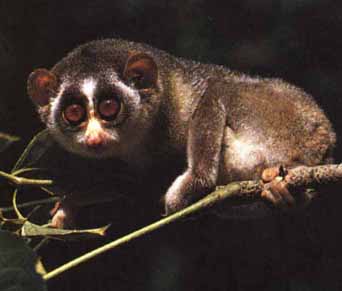 |
 |
In fact, one of the driving factors toward color vision is thought to be the ability to identify fruit, which provides tasty and easily digested food, rather than leaves, which are everywhere and therefore easy to find, but are much harder to digest. (from J. Allman, "Evolving Brains") |
| Color vision and the ability to find fruit is one example of a cycle shown to the right. Animals face a tradeoff between easily found, difficult to digest food (leaves, say), and difficult to find easily digested food (peaches). They have to make a good choice in this trade, or their type will starve and die out. Thus, evolution can lead to finnicky-eating animals with very large brains to be used in finding the right kind of rare, but easily digested food. Or it can lead to less picky eaters who do not need that much brainpower to find abundant, but more difficult to digest food. Thus, the tradeoff comes down to whether an animal has a large brain and sophisticated nervous and sensory system, but a small gut for digestion; or a well developed powerful digestive system, but a less capable brain since finding food is less challenging. In fact, the encephalization in fruit-eating apes (chimpanzees, for example) is substantially higher than in leaf-eating ones (say, gorillas), supporting this picture. (animation by G. Rieke) |  |
A powerful new tool for studying evolution comes from examining DNA of different species, seeing how many differences there are between them. It appears that, roughly, successful errors in DNA replication that survive to create modified species occur at very nearly a constant rate (this concept is sometimes called the molecular clock). There is just over 1% difference in DNA between humans and chimpanzees or gorillas - we are nearly 99% the same as them in terms of our DNA! We conclude that all three species - humans, chimpanzees, gorillas - separated and began independent evolution from a common ancestor about 5 million years ago. Although all three types were well along toward the powerful brain, simple digestive system solution, humans carried it far, far further as can be seen by the comparison below.
| Comparison of a chimpanzee brain (left) and human brain (right) (from J. Allman, "Evolving Brains") |
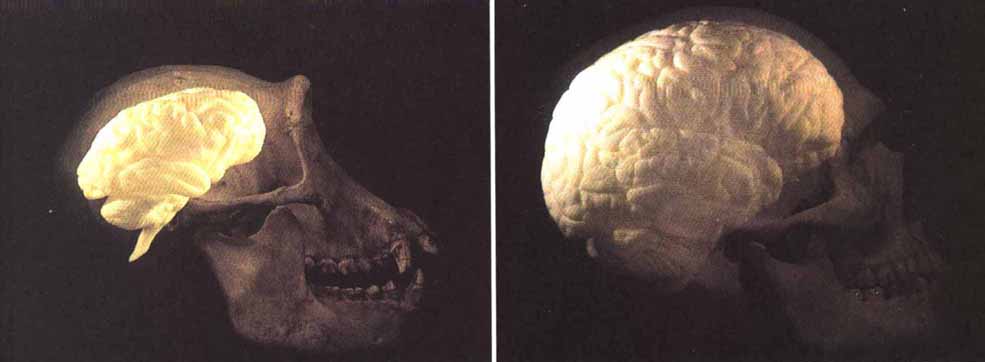 |
| In fact, humans have pushed the "brainy" solution to some kind of limit. The figure to the right (from J. Allman, "Evolving Brains") shows the portion of basic body energy devoted to different functions as a human grows from an infant (5 kg body weight) to a typical adult (70 kg). Two thirds of the energy of an infant is devoted to maintaining and growing a large brain, and even for an adult 25% of the body energy is devoted to the brain. No wonder babies are so helpless!!!! There is no way that they could tolerate spending any more energy on their brains. | 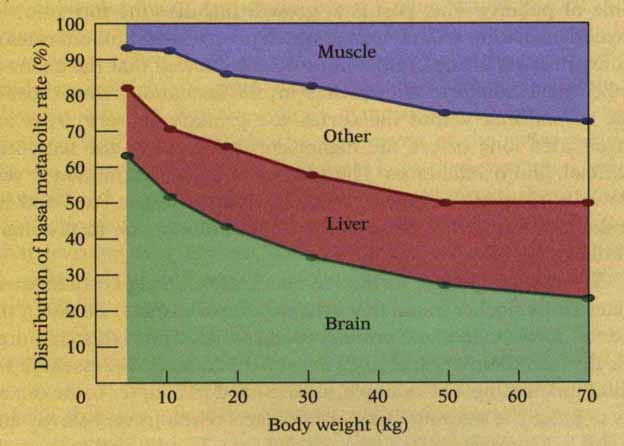 |
Given that it evolved eventually on Earth, how likely is it for intelligent life
to evolve given a suitable planet![]()
We have described a scientific description of the formation of the Universe and
evolution of intelligent life. Although religious versions of the same events can differ
substantially, there should be no inevitable conflict ![]() .
.
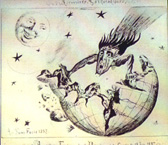 A comet rips the earth
apart in this 19th century cartoon, (From C. Chapman, http://www.boulder.swri.edu/clark/chance/23oldcom.jpg) A comet rips the earth
apart in this 19th century cartoon, (From C. Chapman, http://www.boulder.swri.edu/clark/chance/23oldcom.jpg) |
 |
|
Click to return to syllabus |
||
| Click to return to Mass Extinctions | hypertext |
Click to go to Contacting Other Civilizations |